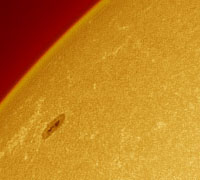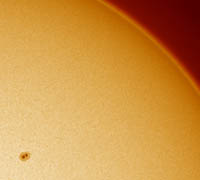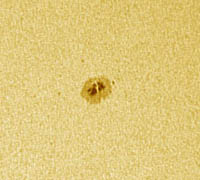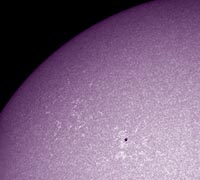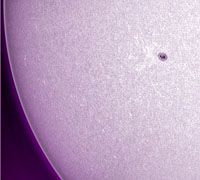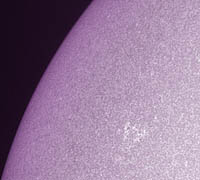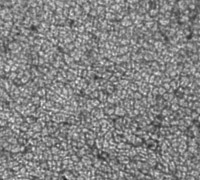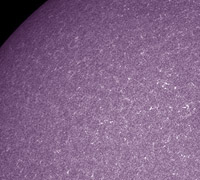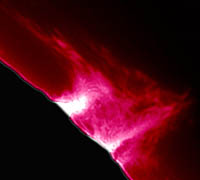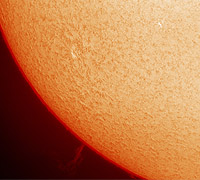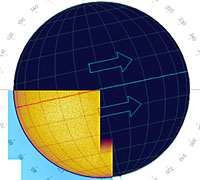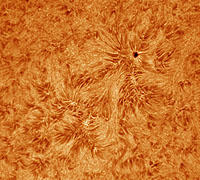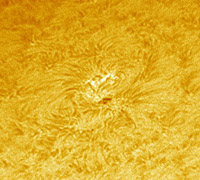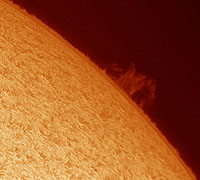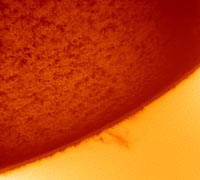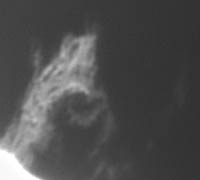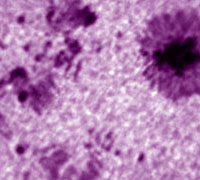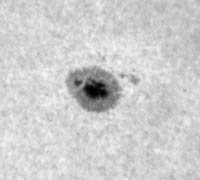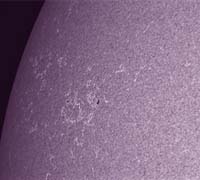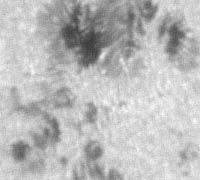Malvazinky Observatory in Prague
Quick Nav:
Photographs: Deep Sky | Solar Photosphere | Solar Chromosphere (Hα)
|
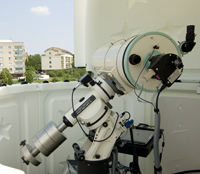 |
My Projects
March 2013:
DStation Deconvolution Software version 0.5 alpha 5 Released
Description: DStation is a BSD licensed cross-platform software implementing various image deconvolution methods described in J. S. Lim, “Two-dimensional signal and image processing,” Prentice Hall, (1990) and other sources. DStation is a GUI testbed for various not so well known image deconvolution algorithms. It can be used for various applications, including astronomical image processing. One of the algorithms implemented was developed by me and is based on a MIT handbook by J. S. Lim. This method is called "Usatov, Atmospheric" in the DStation, and the description how it works is here.
DStation 0.5 alpha 5 build for FreeBSD
DStation 0.5 alpha 5 build for Windows
DStation 0.5 alpha 5 build for Macintosh
October 2011:
Possible nova discovered in M32 galaxy by S. Korotkiy and V. Gerke.
Description: Assisted to confirm the PNV J00424277+4052017 event.
June 2010:
Post-processing Ultra-Deep M51 - The Whirlpool Galaxy: International Collaboration
Description: How deep amateurs can go? The Hubble Ultra Deep Field has inspired amateurs from the very first moment it became available. In 2010, Yuri Toropin, PhD, has started an international collaboration project whereby many amateurs worldwide have submitted their M51 imaging data into a single large dataset. This is my own version of processing this wonderful collection of photons.
July 2008:
Super-resolution Solar Photosphere Granulation Imaging
Description: A successful attempt to image Solar granulation with an amateur 280mm Schmidt-Cassegrain telescope located in Central Europe. A number of post-processing techniques have been applied, including Wien filter rescale, Lucy-Richardson deconvolution, QE Super-resolution rescale to achieve the result. This comparison shows that an amateur instrument still can achieve significant results if compared to very expensive professional telescopes. Publications: Sky & Telescope, November 2008 issue and Astronomy Now, November 2010 issue.
May 2008:

Days of open doors at Ondrejov observatory near Prague: Photoreport
May 2008:
Third publication in OEJV, issue 88: 108 New Variable Stars in the NSVS Database
 #88
#88
Description: In this paper we present 105 SR+L, 1 Orion T Tau and 2 RS CVn type variable stars found in the Northern Sky Variability Survey (NSVS) database. This work is designated to complement and finalize our previous publication of the Extended Catalog of Red AGB Variable Stars found in the NSVS database as is primarily designated to find SR+L stars. While the previous work employed the AOV ratio cutoff at >1.6 to pick stars showing slow variability pattern, we have manually processed all the remaining objects originally filtered out by the smaller AOV ratio and picked the ones with light curves showing obvious variability pattern. All the stars presented have no identification in General Catalogue of Variable Stars, SIMBAD and VSX databases thus most likely the stars presented are new discoveries.
appendix: Elements 18 kB
appendix: Cross-IDs 5 kB
April 2008:
Second publication in OEJV, issue 87: "The Extended Catalogue of Red AGB Variable Stars found in the NSVS database "
 #87
#87
Description:
In this paper we present the catalog of new Mira-type and SR+L variable stars in the Northern Sky Variability Survey (NSVS) database, found after complementing the original NSVS object tables with a number of additional parameters. By extending the amount of criterias search queries can take advantage of and filtering known objects out, it became convenient to apply better constrained filters to search new variable star candidates. As an example of presented approach, the quest for red variables has resulted in 78 Mira-type and 717 SR+L stars found that have no identification in General Catalogue of Variable Stars, SIMBAD and VSX databases. Most likely the stars presented are new discoveries. The classification of these stars is based on the near-infrared colors from Two Micron All Sky Survey (2MASS) photometry, amplitude and period with the accuracy of the classification given ~90%, estimated basing on the current GCVS classification scheme.
appendix: Catalogue - Elements 142 kB
appendix: Catalogue - USNO-A2.0 and SIMBAD Cross-IDs 35 kB
appendix: Light Curves 1676 kB
appendix: Readme file for supplemental analysis data 0 kB
February 2008:
My first publication in a referred journal OEJV, issue 81: "New Variable Stars in the NSVS database"
 #81
#81
Description: 27 new variable stars discovered in the Northern Sky Variabiltiy Survey database, mostly red AGB branch semiregular and irregular variable stars.
December 2007:
D. Knisley's
"Observing the Sun in H-Alpha" translated to Russian.
May 2007:
First run of VSR with Milky Way Galactic Plane Transit
![]() This project was mentioned in NASA's RadioJove June 2007 bulletin,
This project was mentioned in NASA's RadioJove June 2007 bulletin,
thanks to NASA RadioJove team!

Description: By monitoring noise levels at 22.09 MHz, we have been able to capture synchrotron emission of our own galaxy during it's transits through the skies of Balovka. A complete Radio Skypipe chart data of the event is available as SPD (16.7Mb averaged version)
November 2006:
Amateur Search for Exoplanets

Description: Project ASE has been started to get a better understanding of the processing techniques used for exoplanet search using radio velocity method. Currently ASE is a complete software suite which incorporates Genetic Algorithms for automated model search, model polishing using Levenberg-Marquardt and Multiobjective Goal Attainment procedures, Lomb-Scargle periodogram, bootstrap analysis and orbital stability checks. ASE has been mentioned in my publication at Ka-Dar Info Newsletter, #5 2007. If you wish to obtain the latest version of ASE software, please write me an e-mail.
September 2006:
Nomenclature of M42, restored after historical observations of Herschel, Struve and Rosse published at SEDS

Description: M42, the Great Orion Nebula, is probably one of the most interesting objects in the sky. The amount of details visible in a telescope of even very small diameter is exciting. This small project is an attempt to help ourselves to stay more oriented when referring to the visible features of M42. Comments and corrections are very welcome.
September 2006:
First spectroscopic observations of bright stars with Planck curve fits

Description: This is the first "serious" trial to spectroscopic analysis with a Paton Hawskely SA100 diffraction grating filter on an undriven 127mm Maksutov-Cassegrain and SPC900NC camera.
MET9 Satellite Image of Europe (Visible)
Other satellite image sources

Click for full scale version (1.2Mb)
Unisys 300mb Wind Speed over Europe
300mb wind speed is considered to be a good indicator of astronomical seeing. Pink zones represent areas with low wind speeds whereby periods of excellent seeing are likely. Damian Peach provides good description on seeing forecast. SkippySky Europe Page: alternative astronomy weather resource by Andrew Cool from Australia.
Solar SOHO MDI Continuum Latest Image

My observatory equipment:
Aries 10" f/15 Maksutov-Cassegrain Telescope
Skyshed POD
Telescope Startup Procedures



